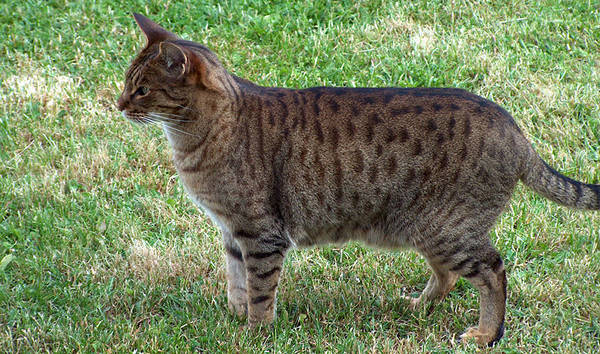
Maus are more temperature sensitive than most breeds-they are fond of very warm temperatures. The Mau is known for having what is considered a loyal, playful and friendly personality. All Maus must have green eyes, but an amber cast is acceptable in kittens and young adults up to eighteen months old. Black and pewter Maus cannot be shown, but may be used in breeding. From most to least common, these colours are silver, bronze, smoke, black, caramel and blue/pewter. One of the most important recognizable traits of this breed is a long, dark, dorsal stripe that runs from its head to its tail along its spine. Maus have been clocked running more than 48 km/h (30 mph).
#BLACK SPOTTED TABBY CAT SKIN#
The Egyptian Mau is the fastest of the domestic cats, with its longer hind legs, and unique flap of skin extending from the flank to the back knee, which assists in running by allowing the legs to stretch back farther, providing for greater agility and length of stride. Its medium-length body is muscular, with the hind legs longer than the front, giving the Mau the appearance of standing on tiptoes when upright." The breed conformation is described as "a balance between the compactness of a Burmese and the slim elegance of a Siamese. Characteristics Black silver spotted tabby Mau Black smoke MauĮgyptian Maus are considered by proponents to be one of the progenitor breeds of the modern domestic cat. In 2018, the Egyptian Mau ranked at position 27 out of 45 cat breeds registered with the Cat Fanciers' Association (CFA). In 2022, only 39 Mau kittens were registered at the GCCF, ranking the cat breed at position 27 out of 40 breeds in popularity. Fewer than 200 kittens are registered with the Governing Council of the Cat Fancy (GCCF, predominantly in the UK) each year. Egyptian Maus are a relatively rare breed worldwide. Similar to other officially recognised cat breeds, the term “Egyptian Mau” is only meant to be used for cats from this specific breed, which are by definition all purebred cats with a known and formally registered ancestry, also known as the cat’s “paperwork”. Ī Bengal breeder named Jean Mill also made some contributions to the breed. Those with the latter tend to be from the United States. This mix became the basis for the Ocicat.Įgyptian Maus will have either a "scarab beetle" or "M" marking on their foreheads. There were attempts by British breeders to create Maus from cross-breeds of Abyssinians, Siamese and tabbies, however, these did not resemble the true Maus. The Mau achieved championship status in some organizations in 1968. The East Mediterranean/Anatolian group is omitted because breeds that supposedly originate in that geographic area do not do so. The phylogenetic tree published in PlosOne demonstrates that the Egyptian Mau belongs to the group of Western-derived breeds.

The feline genome data published in the Pentascope document shows the Egyptian Mau to be very closely related to the Maine Coon, Korat, and American Turkish Angoras (not distinguishable from native Turkish Angoras). Historical evidence points to the Mau being an Egyptian breed.

The spots of the Mau occur on only the tips of the hairs of its coat. They are one of the few naturally spotted breeds of domesticated cat. Brown Tabby markings can be found in almost any breed, including popular breeds like Maine Coons, Bengals, British Shorthairs, and almost all crossbreeds.The Egyptian Mau is a small to medium-sized short-haired cat breed. The term “Tabby” refers to a type of pattern, not a specific breed.

The 7 Fascinating Facts About the Brown Tabby Cat 1. Here are seven facts about the Brown Tabby that you may not have heard before! While Brown Tabbies are common, they are still an interesting variety with a fascinating history. One only needs to think of one of the most famous cats of all, Garfield, to picture the Tabby pattern in all its glory! The Tabby pattern is legendary among cat owners, due to the unique way that it presents itself in different breeds and its nod to the wildcat heritage of Tabby cats. Almost everyone has owned a Tabby cat or has a friend who owns one, and this is especially true of brown and orange variations.

The Brown Tabby Cat is a commonly found feline in household homes, and although they are common, they are no less beautiful.


 0 kommentar(er)
0 kommentar(er)
